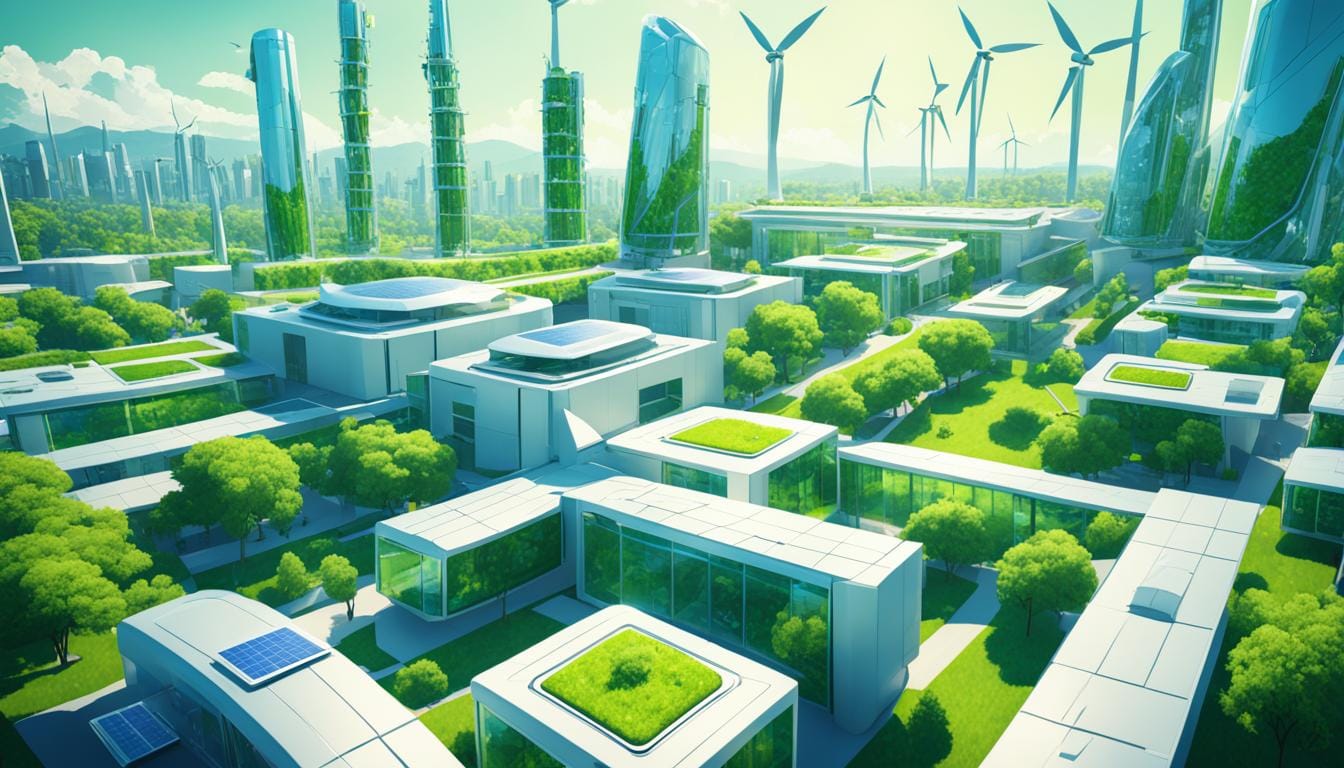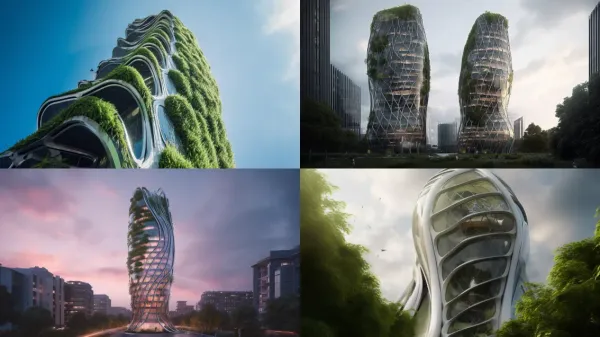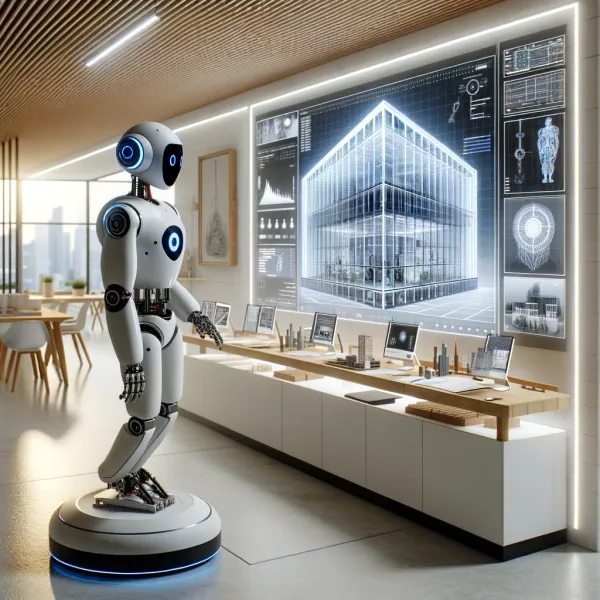How to design sustainable buildings with AI
Explore how AI for sustainable building is revolutionizing the AEC industry by optimizing design for eco-friendliness and efficiency.

Have you ever walked through a city and marveled at the architectural wonders that surround you? The towering skyscrapers, the sleek and modern designs, the harmonious blend of functionality and beauty. But have you ever stopped to think about the environmental impact of these structures? The energy they consume, the materials they use, and the waste they generate?
As someone who is passionate about the environment and the future of our planet, I have often pondered these questions. How can we create buildings that not only meet our needs but also contribute to a sustainable future? That's when I discovered the incredible potential of artificial intelligence (AI) in the field of architecture and design.
I have an online course where you could learn how to automate your architecture studio work to save time while designing better projects.
This AI in AI in AEC online course is by subscription with one lesson a week.
AI has the power to revolutionize the way we design and construct buildings, making them more eco-friendly, energy-efficient, and sustainable. By employing AI algorithms, architects and designers can analyze vast amounts of data and simulate different scenarios to create sustainable buildings that harmonize with their surroundings. From the selection of materials to energy optimization and the integration of renewable energy sources, AI can truly transform the way we approach sustainable architecture.
In this article, we will explore the role of AI in sustainable building design and delve into its various applications. We will uncover how AI can optimize building performance, aid in material selection, integrate renewable energy sources, and even streamline the process of obtaining green building certifications. Join me as we discover the exciting possibilities that AI brings to the world of sustainable architecture.
Key Takeaways:
- AI has the potential to revolutionize the architecture, engineering, and construction (AEC) industry by optimizing building design for eco-friendliness and efficiency.
- AI algorithms can analyze large sets of data and simulate various scenarios to create sustainable buildings that harmonize with their surroundings.
- AI can assist in the selection of materials, energy optimization, and the integration of renewable energy sources, making it an essential tool for sustainable architecture.
- By automating repetitive tasks, AI frees up architects' time to focus on creativity and innovation, ultimately leading to more innovative and sustainable building designs.
- AI can continuously analyze data from sensors and monitoring devices to optimize building performance, improve energy efficiency, and predict maintenance needs.
The Role of AI in Architectural Design
AI technology plays a crucial role in revolutionizing the field of architectural design, offering numerous benefits for architects and designers. By harnessing the power of AI algorithms, architects can generate design options tailored to specific requirements and optimize them for sustainability.
One of the key advantages of AI in architectural design is its ability to analyze environmental factors and create efficient building designs. Through the analysis of data on solar exposure, wind patterns, and energy consumption, AI can generate designs that minimize environmental impact and maximize energy efficiency.
In addition to environmental analysis, AI also automates repetitive tasks, freeing up architects' time to focus on creativity and innovation. By eliminating manual labor in tasks such as drafting and 3D modeling, AI enables architects to channel their energy into creating unique and inspiring designs.
AI also empowers architects to make data-driven decisions by providing real-time feedback on the environmental impact of design choices. Through AI algorithms, architects can assess the sustainability of different design options and optimize their choices to achieve maximum eco-friendliness.
To illustrate the role of AI in architectural design, consider the following example:
Architects at a leading design firm utilized AI algorithms to analyze the environmental conditions of a proposed building site. The AI system assessed factors such as solar exposure, wind patterns, and energy consumption to generate an optimized design that integrated passive solar strategies, natural ventilation, and renewable energy sources. The result was a sustainable building design that minimized energy consumption and reduced environmental impact.
Through its various applications, AI is transforming the architectural design process, enabling architects to create sustainable and innovative buildings that harmonize with their surroundings. By leveraging AI in architecture design, we can move closer to a future where sustainable architecture becomes the norm.
| Benefits of AI in Architectural Design | Examples |
|---|---|
| Generation of design options based on specific requirements | AI algorithms analyze user preferences and project constraints to create design options that meet the client's needs. |
| Optimization of designs for sustainability | AI algorithms analyze environmental factors and optimize designs to minimize energy consumption and environmental impact. |
| Automation of repetitive tasks | AI automates tasks such as drafting and 3D modeling, freeing up architects' time for creative and innovative work. |
| Data-driven decision-making | AI provides real-time feedback on the environmental impact of design choices, enabling architects to make informed decisions. |
AI Applications for Energy Efficiency
AI technology offers a wide range of applications for improving energy efficiency in buildings. By harnessing the power of AI algorithms, we can optimize the operation of heating, ventilation, and air conditioning (HVAC) systems, monitor real-time energy consumption, and make data-driven adjustments for sustainable energy optimization. AI also plays a vital role in utilizing natural light effectively, reducing the need for artificial lighting and resulting in significant energy savings.
Through advanced data analysis, AI algorithms can analyze energy usage patterns and environmental conditions to optimize HVAC systems. By adjusting temperature setpoints, airflow rates, and other variables, AI can ensure that buildings are heated, cooled, and ventilated efficiently, minimizing energy waste. Additionally, AI can integrate with smart sensors and Internet of Things (IoT) devices to monitor energy consumption in real-time. This allows for proactive energy management, identifying energy-intensive areas and implementing energy-saving measures promptly.
One of the key benefits of AI in energy efficiency is its ability to optimize the use of natural light in buildings. By analyzing factors such as building orientation, window placement, and shading devices, AI algorithms can determine the optimal amount of natural light that enters a space. This not only creates a more comfortable and productive environment but also reduces the reliance on artificial lighting, leading to substantial energy savings.
"AI applications in energy efficiency have the potential to transform the way buildings consume and conserve energy, contributing to a more sustainable future."
Furthermore, AI algorithms can utilize historical data and predictive analytics to forecast energy demand and adjust energy consumption accordingly. This dynamic energy management ensures that energy usage aligns with actual needs, minimizing energy waste during periods of low occupancy or decreased energy demand.
To visualize the impact of AI applications for energy efficiency, consider the following table:
| Energy Efficiency Solution | Description |
|---|---|
| HVAC Optimization | AI algorithms analyze energy usage patterns and environmental conditions to optimize HVAC systems, reducing energy waste and improving overall system efficiency. |
| Real-time Energy Monitoring | AI integrates with smart sensors and IoT devices to monitor energy consumption in real-time, facilitating proactive energy management and optimization. |
| Natural Light Optimization | By analyzing building orientation, window placement, and shading devices, AI algorithms optimize the use of natural light, reducing the need for artificial lighting and saving energy. |
| Dynamic Energy Management | Through historical data analysis and predictive analytics, AI algorithms forecast energy demand and adjust energy consumption to align with actual needs, minimizing energy waste. |
By leveraging the power of AI, we can unlock significant energy-saving potentials and create more sustainable buildings. The integration of AI applications for energy optimization not only reduces energy consumption and related costs but also contributes to the global efforts towards sustainable energy usage.

AI for Material Selection
When it comes to building construction, selecting sustainable materials is a critical aspect of creating eco-friendly structures. With the help of AI technology, architects and designers can make more informed decisions in this regard. AI algorithms analyze the properties and environmental impact of various materials to recommend alternatives that are not only more sustainable but also have a lower carbon footprint.
AI goes beyond just considering the environmental aspects of materials. It also takes into account factors such as durability, recyclability, and energy efficiency. By doing so, AI assists architects and designers in choosing the most sustainable materials for their projects, thereby promoting a more sustainable approach to building construction.
In the table below, we highlight some of the key ways in which AI can aid in material selection for sustainable building construction:
| AI in Material Selection for Sustainable Building Construction |
|---|
| Analysis of material properties and environmental impact |
| Recommendation of more sustainable alternatives |
| Consideration of durability, recyclability, and energy efficiency |
By leveraging AI capabilities, architects and designers can create structures that not only meet the desired aesthetic and functional requirements but also contribute to a more sustainable built environment. The use of sustainable materials not only reduces the environmental impact of buildings but also leads to long-term cost savings and improved energy efficiency.
In the pursuit of sustainable construction, AI plays a key role in guiding material selection and promoting environmentally conscious decision-making.
AI for Building Performance Optimization
Artificial Intelligence (AI) is revolutionizing the way buildings are optimized for performance in terms of comfort, efficiency, and sustainability. By leveraging advanced algorithms and real-time data analysis, AI can unlock the full potential of building systems, leading to significant improvements in energy consumption and operational efficiency.
One of the key capabilities of AI in building performance optimization is its ability to continuously monitor and analyze data collected from sensors and other monitoring devices. By monitoring factors such as temperature, humidity, occupancy patterns, and energy usage, AI algorithms can make real-time adjustments to building systems to ensure optimal comfort while minimizing energy waste.
With AI, buildings can adapt to changing environmental conditions, occupancy patterns, and user preferences. For example, AI can dynamically adjust HVAC systems to maintain optimal temperature and humidity levels based on real-time data, ensuring a comfortable environment for occupants while minimizing energy consumption.
"AI algorithms can optimize building systems, leading to improved energy efficiency, reduced carbon footprint, and enhanced occupant comfort."
AI can also predict maintenance needs by analyzing historical data and identifying patterns that indicate potential system failures or inefficiencies. By detecting issues at an early stage, AI enables proactive maintenance, reducing downtime, and preventing costly repairs.
Furthermore, AI can identify potential energy-saving opportunities by analyzing data and recommending energy-efficient strategies. This can include suggestions for reducing energy consumption during periods of low occupancy or optimizing the use of natural light to minimize the reliance on artificial lighting.
By harnessing the power of AI, buildings can achieve higher sustainability standards, contribute to environmental conservation, and reduce operating costs. The implementation of AI-driven building performance optimization can lead to improved energy efficiency, reduced carbon footprint, enhanced occupant comfort, and overall better building management.
| Benefits of AI in Building Performance Optimization |
|---|
| Improved energy efficiency |
| Enhanced occupant comfort |
| Reduced operational costs |
| Proactive maintenance |
| Optimized utilization of natural resources |
By leveraging AI for building performance optimization, architects, engineers, and building managers can unlock the full potential of their buildings, creating sustainable and intelligent environments that benefit both occupants and the planet.

AI for Renewable Energy Integration
With the pressing need to transition towards sustainable energy sources, AI is playing a pivotal role in integrating renewable energy into building design. By harnessing the power of AI algorithms and data analysis, architects and designers can optimize the placement of solar panels, wind turbines, and other renewable energy systems to maximize energy generation and reduce dependence on fossil fuels.
By analyzing data on available solar and wind resources, AI algorithms can assess the feasibility and efficiency of renewable energy integration in specific locations. This enables architects to make informed decisions on the design and placement of renewable energy systems in their projects.
"AI algorithms can optimize the placement of solar panels, wind turbines, and other renewable energy systems to maximize energy generation."
Moreover, AI's predictive capabilities extend to energy demand patterns. By analyzing historical data and considering factors such as weather conditions and occupancy patterns, AI algorithms can accurately predict and optimize energy production and storage. This ensures a reliable and efficient supply of renewable energy, irrespective of fluctuations in demand.
Table: Benefits of AI in Renewable Energy Integration
| Advantages | Description |
|---|---|
| Optimized placement | AI algorithms analyze solar and wind data to determine the optimal position for renewable energy systems, maximizing energy generation. |
| Predictive energy management | AI algorithms analyze historical and real-time data to predict energy demand patterns, allowing for efficient energy production and storage. |
| Sustainability integration | AI facilitates the integration of renewable energy sources into building design, reducing dependence on fossil fuels and promoting sustainability. |
| Cost savings | By optimizing energy production and storage, AI helps reduce energy costs and enhance the financial viability of renewable energy systems. |
The integration of AI in renewable energy design not only promotes environmental sustainability but also presents significant economic benefits. By leveraging AI's capabilities, architects and designers can create buildings that not only consume less energy but also generate clean and renewable power, contributing to a greener and more sustainable future.
AI for Green Building Certification
In the world of sustainable construction, obtaining green building certifications is a crucial step towards creating eco-friendly structures. However, the process can be time-consuming and labor-intensive, requiring extensive data collection and analysis. This is where AI comes in, revolutionizing the certification process and making it more efficient.
AI algorithms, fueled by vast amounts of data, can assess various criteria such as energy efficiency, water conservation, and indoor air quality. By analyzing these factors, AI algorithms can accurately determine a building's compliance with sustainability standards. This automated analysis saves architects and developers valuable time and resources, allowing them to focus on designing and constructing sustainable structures.
One prominent green building certification in the industry is LEED (Leadership in Energy and Environmental Design). AI can assist architects and developers in achieving LEED certification by providing accurate and reliable data. With AI's ability to streamline the collection and analysis of sustainability-related data, the certification process becomes more efficient and less cumbersome.
"AI algorithms can automate data collection and analysis, making the process of obtaining green building certifications more efficient."
By leveraging AI for green building certification, architects and developers are empowered to create sustainable structures that meet the highest environmental standards. This not only benefits the environment but also enhances the reputation of projects and brands that prioritize sustainability. With AI's assistance, the construction industry can embrace sustainable practices and contribute to a greener future.
| Benefits of AI for Green Building Certification | Examples |
|---|---|
| Saves time and resources | Automated data collection and analysis |
| Accurate and reliable data | AI algorithms ensure precision in determining compliance |
| Streamlines the certification process | Efficiently assesses sustainability criteria |
AI for Lifecycle Assessment
As sustainability becomes an increasingly important aspect of building design, AI is playing a crucial role in performing lifecycle assessments of buildings. By analyzing the environmental impact of a building from construction to demolition, AI algorithms can provide valuable insights for architects and designers.
Through comprehensive analysis of factors such as materials, energy consumption, and waste generation, AI can identify opportunities for improvement and suggest strategies to minimize the environmental footprint of buildings. This data-driven approach enables architects to make informed decisions and prioritize sustainable design choices throughout the building's lifecycle.
One of the key benefits of using AI for lifecycle assessment is its ability to simulate different scenarios and evaluate the long-term sustainability of design choices. By running simulations, architects can gain a better understanding of how their design decisions impact the environment and identify areas where further optimization is needed.
AI algorithms can also provide real-time feedback on the environmental impact of design choices, helping architects make adjustments early in the design process. This proactive approach allows architects to make more sustainable design decisions from the outset, reducing the need for expensive and time-consuming retrofitting later on.
A comprehensive lifecycle assessment can be visualized through the following table:
| Stage | Environmental Impact | Sustainable Strategies |
|---|---|---|
| Construction | High energy consumption and carbon emissions during material production and transportation | Optimize material selection for lower embodied energy and carbon footprint. Use locally sourced materials to reduce transportation emissions. |
| Operation | Energy consumption, water usage, and indoor air quality | Implement energy-efficient systems, optimize water usage, and ensure good indoor air quality through proper ventilation. |
| Maintenance | Energy consumption, waste generation from maintenance activities | Adopt proactive maintenance practices to minimize energy consumption and waste generation. Implement a waste management plan for disposal. |
| Demolition | Waste generation and environmental impact from demolition | Design for deconstruction to facilitate material reuse and recycling. Minimize waste generation during demolition. |
By leveraging AI for lifecycle assessment, architects and designers can create buildings that are not only aesthetically pleasing but also environmentally sustainable. This holistic approach to building design ensures that every stage of a building's lifecycle is optimized for minimal environmental impact, contributing to a greener and more sustainable future.
Conclusion
In conclusion, AI has the potential to revolutionize the AEC industry and contribute to the creation of sustainable buildings. By harnessing AI technology, architects and designers can make data-driven decisions that optimize building performance and enhance energy efficiency. Through AI-powered algorithms, the selection of sustainable materials can be streamlined, leading to the use of eco-friendly alternatives and reduced carbon footprints. The integration of renewable energy sources can also be maximized, ensuring a reliable and efficient supply of clean energy.
Furthermore, AI can play a crucial role in lifecycle assessments, analyzing the environmental impact of buildings from construction to demolition. By simulating different scenarios and evaluating long-term sustainability, AI can inform architects and designers about the most environmentally friendly choices. Additionally, AI offers the ability to automate the process of obtaining green building certifications by providing accurate and reliable data for compliance assessment.
With AI for sustainable building and sustainable architecture in the AEC industry, a more sustainable future in the built environment is within reach. By leveraging the power of AI, architects and designers can create buildings that are not only efficient and eco-friendly but also contribute to a greener planet for generations to come.
FAQ
Can AI help to design sustainable buildings?
Yes, AI has the potential to revolutionize the architecture, engineering, and construction (AEC) industry by optimizing building design for eco-friendliness and efficiency. By using AI algorithms, architects and designers can analyze large sets of data and simulate various scenarios to create sustainable buildings. AI can also assist in the selection of materials, energy optimization, and the integration of renewable energy sources, making it an essential tool for sustainable architecture.
What is the role of AI in architectural design?
AI technology offers several benefits in the field of architectural design. It can generate design options based on specific requirements and optimize them for sustainability. AI algorithms can analyze environmental factors such as solar exposure, wind patterns, and energy consumption to create efficient building designs. By automating repetitive tasks, AI also frees up architects' time to focus on creativity and innovation. Additionally, AI can help architects make data-driven decisions by providing real-time feedback on the environmental impact of design choices.
How can AI improve energy efficiency in buildings?
AI can play a crucial role in improving energy efficiency in buildings. By analyzing energy usage patterns and environmental conditions, AI algorithms can optimize the operation of heating, ventilation, and air conditioning systems. AI can also integrate with smart sensors and IoT devices to monitor energy consumption in real-time and make adjustments accordingly. Additionally, AI can optimize the use of natural light to reduce the need for artificial lighting, resulting in significant energy savings.
How does AI help with material selection in building construction?
AI can aid in the selection of sustainable materials for building construction. By analyzing the properties and environmental impact of various materials, AI algorithms can recommend alternatives that are more eco-friendly and have a lower carbon footprint. AI can also consider factors such as durability, recyclability, and energy efficiency to guide architects and designers in choosing the most sustainable materials for their projects.
How can AI optimize building performance?
AI can optimize the performance of buildings by continuously analyzing data collected from sensors and other monitoring devices. By monitoring factors such as temperature, humidity, and occupancy patterns, AI algorithms can adjust building systems in real-time to ensure optimal comfort and energy efficiency. AI can also predict maintenance needs and identify potential issues before they become major problems, leading to cost savings and improved building performance.
How can AI help with the integration of renewable energy sources?
AI can help architects and designers integrate renewable energy sources into building design. By analyzing data on available solar and wind resources, AI algorithms can optimize the placement of solar panels, wind turbines, and other renewable energy systems to maximize energy generation. AI can also predict energy demand patterns and adjust energy production and storage accordingly, ensuring a reliable and efficient supply of renewable energy.
Can AI streamline the process of obtaining green building certifications?
Yes, AI can streamline the process of obtaining green building certifications by automating data collection and analysis. AI algorithms can assess various criteria, such as energy efficiency, water conservation, and indoor air quality, to determine a building's compliance with sustainability standards. By providing accurate and reliable data, AI can assist architects and developers in achieving certifications such as LEED (Leadership in Energy and Environmental Design) more efficiently.
How can AI contribute to lifecycle assessment in building design?
AI can perform lifecycle assessments of buildings, analyzing their environmental impact from construction to demolition. By considering factors such as materials, energy consumption, and waste generation, AI algorithms can identify opportunities for improvement and suggest strategies to minimize the environmental footprint of buildings. AI can also simulate different scenarios and evaluate the long-term sustainability of design choices, helping architects make informed decisions throughout the building's lifecycle.
How can AI revolutionize sustainable building?
AI has the potential to transform the AEC industry by optimizing building design for sustainability and efficiency. From energy optimization to material selection and lifecycle analysis, AI offers various applications that can contribute to the creation of sustainable buildings. By harnessing the power of AI, architects and designers can make data-driven decisions, optimize building performance, and integrate renewable energy sources, ultimately leading to a more sustainable future in the built environment.
Read more







